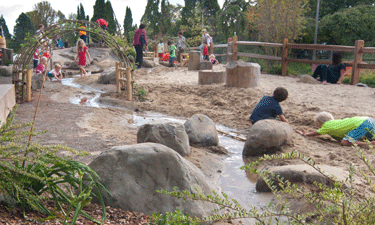 In a city known for innovation and residents’ love of the outdoors, Portland, Oregon, recently opened its first nature-based play area at Westmoreland Park. On any given day, the park’s new nature-based play area may be filled with hundreds of children playing in the sand and water, climbing on massive boulders and log features and building forts with branches. Adults watch the imaginative play inspired by the natural elements, and also participate with children in exploring the play area’s unique features. Portland Parks and Recreation saw a great opportunity to target this site as a nature-based play pilot project in the Portland parks system, and to replace the park’s outdated play area.
In a city known for innovation and residents’ love of the outdoors, Portland, Oregon, recently opened its first nature-based play area at Westmoreland Park. On any given day, the park’s new nature-based play area may be filled with hundreds of children playing in the sand and water, climbing on massive boulders and log features and building forts with branches. Adults watch the imaginative play inspired by the natural elements, and also participate with children in exploring the play area’s unique features. Portland Parks and Recreation saw a great opportunity to target this site as a nature-based play pilot project in the Portland parks system, and to replace the park’s outdated play area.
Design Process
Nothing is traditional about Westmoreland Park’s nature-based play project. The Portland-based firm GreenWorks, P.C. led a design team, working closely with Portland Parks and Recreation and engaging in extensive public outreach that revealed tremendous community support for nature-based play. The design team collaborated with environmental artist Adam Kuby on the play area’s overall conceptual design. The theme behind the design tells the story of the restored Crystal Springs Creek flowing through the park. The designers developed a sequence to the spaces that metaphorically follows the path of rainwater from the forests of the Cascades to Crystal Springs, accentuated by interpretive poetic messages carved into basalt columns that march along the pathway from the park’s Sequoia grove to the creek channel.
The team developed play-feature details and adhered to national safety guidelines where applicable. While visually engaging, the park is also intended to be safe, secure and maintenance friendly. This meant that a lot of the design process took place in the field. The team labored long in fabricators’ workshops and onsite to determine the acceptable level of risk for each play element, evaluating each boulder and log while still providing beneficial challenges important to childhood development. Team members logged (no pun intended), more time on the construction phase than a traditional playground project.
Natural Materials
Community and staff input informed the selection of mostly natural materials rather than artificial rocks or logs. That choice demanded innovative solutions for design and maintenance.
Sand. The sand-water combination is higher maintenance, but ultimately very rewarding for fueling imaginative play. Sand migrates a lot, and therefore, requires daily maintenance. To minimize maintenance, surfaces adjacent to the sand should be designed to handle sand piling up (like gravel, landscape or lawn areas). Except for access points, walkways adjacent to the sand areas should be limited.
Logs. Eventually, wood rots. Log carpenters were consulted for the massive logs that add a sculptural element to the play area. The team identified three criteria for log detailing: safety, longevity and replaceability. The logs were then detailed such that each log independently “floats” on a metal bracket, secured to concrete footings. This reduces the contact with moisture, ensures logs will not move and allows for each log to be easily replaced in the future.
Boulders. They last forever, but there are safety considerations when building things for children to climb on. Boulders were beautifully composed to fit together without sharp edges and mortared in place for safety.
Inspection and Maintenance
The long-term success of a nature-based play area is dependent upon maintenance and operations staff buy-in. Innovative play areas require equally innovative approaches to maintenance, including a custom inspection and maintenance schedule to address natural materials. To get staff on board, the team held an all-day staff nature-play workshop before design work even started. This included a cross-section of staff, from the bureau director to maintenance and board members. The result of the workshop was staff buy-in, a list of criteria defining what nature-based play means within the park system and clear project goals.
Everybody Plays
The project team knew that the play area would engage a broad age range, but the nature-based approach has exceeded expectations for attracting both the young and the young at heart. On busy days, adults and older children help build sand castles and forts with younger children, or climb on logs and boulders. People come from all over the region for social play dates, and children are entertained for hours. Neighbors stroll through the play area to be a part of the social activity. The play area has become a nucleus of outdoor enjoyment, not only for the neighborhood, but for the city. Within a few short months of opening, Westmoreland has become a success story for what is possible, and what nature play can provide to enhance a community and reconnect people with nature.
Sandra Burtzos, RLA, is a Capital Project Manager for Portland Parks and Recreation’s Design and Construction Services. Ben Johnson, PLA, CPSI, is an Associate and Project Manager at GreenWorks P.C.

